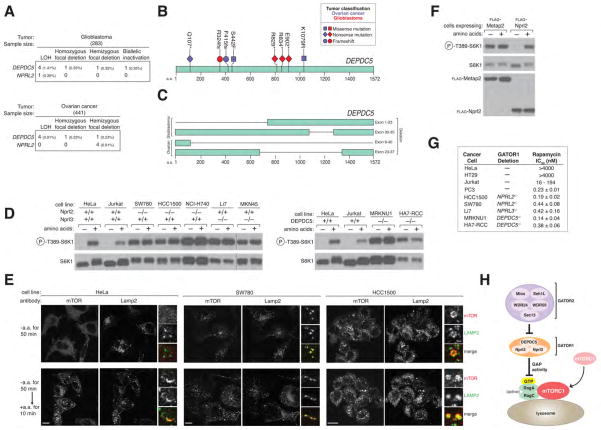Figure 5.
GATOR1 components are mutated in cancer and GATOR1-null cancer cells are hypersensitive to the mTORC1 inhibitor rapamycin. (A) Table summarizing genomic alterations in DEPDC5 and NPRL2 and their frequencies in glioblastoma and ovarian cancer. The ratios of nonsense and frameshift mutations to missense mutations in DEPDC5 (p-value = 0.00015) and NPRL2 (p-value = 0.00342) in glioblastoma differ significantly from the ratio of all nonsense and frameshift mutations to missense mutations in glioblastoma genomes as determined by a fisher exact test. (B)–(C) Mutations and deletions identified in DEPDC5 in glioblastomas and ovarian cancers. (D) In GATOR1-null cancer cells the mTORC1 pathway is resistant to amino acid starvation. Cells were starved of amino acids for 50 min and starved and restimulated with amino acids for 10 min. Cell lysates were analyzed by immunoblotting for levels of the indicated proteins. (E) Cancer cells were starved or starved and restimulated with amino acids for the specified times prior to co-immunostaining for mTOR (red) and Lamp2 (green). In all images, insets show selected fields that were magnified five times and their overlays. Scale bar equals 10 μM. (F) Re-introduction of Nprl2 into the SW780 cell line (NPRL2−/−) restores amino acid-dependent regulation of mTORC1. Cells stably expressing a control protein or Nprl2 were treated and analyzed as in (D). (G) GATOR1-null cancer cells are values for indicated cancer cell lines. hypersensitive to Rapamycin. Rapamycin IC50 Values are presented as mean ± SD (n = 3). (H) Model for the role of the GATOR complex in the amino acid sensing branch of the mTORC1 pathway. GATOR2 is a negative regulator of GATOR1, which inhibits the mTORC1 pathway by functioning as a GAP for RagA.

